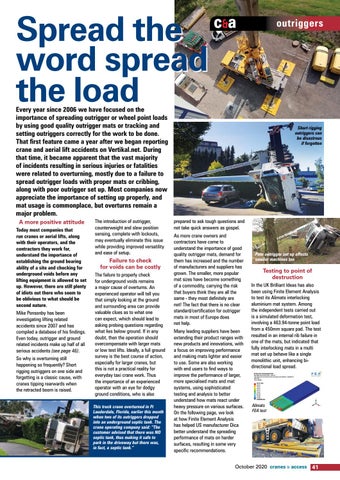Spread the word spread the load
c&a
outriggers
Every year since 2006 we have focused on the importance of spreading outrigger or wheel point loads by using good quality outrigger mats or tracking and setting outriggers correctly for the work to be done. That first feature came a year after we began reporting crane and aerial lift accidents on Vertikal.net. During that time, it became apparent that the vast majority of incidents resulting in serious injuries or fatalities were related to overturning, mostly due to a failure to spread outrigger loads with proper mats or cribbing, along with poor outrigger set up. Most companies now appreciate the importance of setting up properly, and mat usage is commonplace, but overturns remain a major problem. A more positive attitude Today most companies that run cranes or aerial lifts, along with their operators, and the contractors they work for, understand the importance of establishing the ground bearing ability of a site and checking for underground voids before any lifting equipment is allowed to set up. However, there are still plenty of idiots out there who seem to be oblivious to what should be second nature. Mike Ponsonby has been investigating lifting related accidents since 2007 and has compiled a database of his findings. Even today, outrigger and ground related incidents make up half of all serious accidents (see page 46). So why is overturning still happening so frequently? Short rigging outriggers on one side and forgetting is a classic cause, with cranes tipping rearwards when the retracted boom is raised.
The introduction of outrigger, counterweight and slew position sensing, complete with lockouts, may eventually eliminate this issue while providing improved versatility and ease of setup.
Failure to check for voids can be costly The failure to properly check for underground voids remains a major cause of overturns. An experienced operator will tell you that simply looking at the ground and surrounding area can provide valuable clues as to what one can expect, which should lead to asking probing questions regarding what lies below ground. If in any doubt, then the operation should overcompensate with larger mats or low test lifts. Ideally, a full ground survey is the best course of action, especially for larger cranes, but this is not a practical reality for everyday taxi crane work. Thus the importance of an experienced operator with an eye for dodgy ground conditions, who is also This truck crane overturned in Ft Lauderdale, Florida, earlier this month when two of its outriggers dropped into an underground septic tank. The crane operating company said: “The customer advised that there was NO septic tank, thus making it safe to park in the driveway but there was, in fact, a septic tank.�
Short rigging outriggers can be disastrous if forgotten
prepared to ask tough questions and not take quick answers as gospel. As more crane owners and contractors have come to understand the importance of good quality outrigger mats, demand for them has increased and the number of manufacturers and suppliers has grown. The smaller, more popular mat sizes have become something of a commodity, carrying the risk that buyers think they are all the same - they most definitely are not! The fact that there is no clear standard/certification for outrigger mats in most of Europe does not help. Many leading suppliers have been extending their product ranges with new products and innovations, with a focus on improving performance and making mats lighter and easier to use. Some are also working with end users to find ways to improve the performance of larger, more specialised mats and mat systems, using sophisticated testing and analysis to better understand how mats react under heavy pressure on various surfaces. On the following page, we look at how Finite Element Analysis has helped US manufacturer Dica better understand the spreading performance of mats on harder surfaces, resulting in some very specific recommendations.
Poor outrigger set up affects smaller machines too
Testing to point of destruction In the UK Brilliant Ideas has also been using Finite Element Analysis to test its Alimats interlocking aluminium mat system. Among the independent tests carried out is a simulated deformation test, involving a 463.94-tonne point load from a 450mm square pad. The test resulted in an internal rib failure in one of the mats, but indicated that fully interlocking mats in a multi mat set up behave like a single monolithic unit, enhancing bidirectional load spread.
Alimats FEA test
October 2020 cranes & access
41
